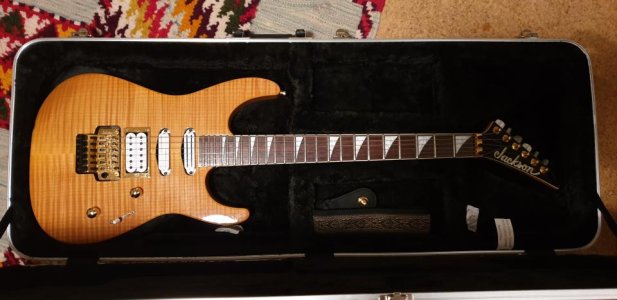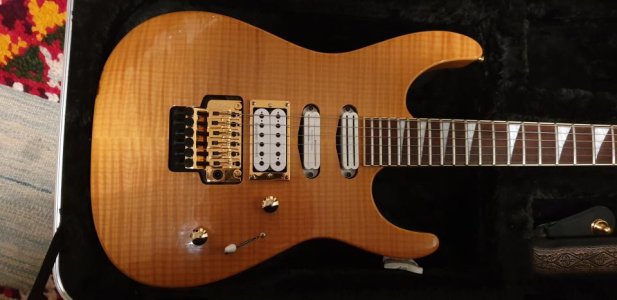Another update on this one for another guitar. In conclusion, yes you can use import locking nuts with higher quality bridges and have good tuning stability.
I built an LTD F-200 with a Schaller Floyd Rose (non-Lockmeister) and a Mastertone VHOn/SPA2. I set it up for Bb standard tuning, 12 gauge strings, and a killswitch.
I kept the import nut and, in the back, the import screws, springs, and claw. I didn't want to use larger screws because they would take out more wood and I didn't want to have to resolder the bridge ground wire to a new claw, so I used what was in the guitar. I didn't worry about a loss of tone due to import parts much. The sustain block was already a bit bigger than normal--42mm--so it stuck out the back cavity a bit. I removed the spring cavity cover and left it off.
The only thing that was Schaller was the bridge: essentially the baseplate, the sustain block, the saddles, the saddle blocks, the whammy bar, etc.
After setting up the claw, truss rod, action, and string length, I used the bar pretty aggressively, dipping it to the wood and pulling the strings sharp about a minor or major third--as far as it would go sharp.
After a few times doing this, the strings stayed in tune, barely moving a few cents on the strobe tuner. Not even 1/4 of a step.
What I've learned:
1) The import nut works fine to keep the strings in tune as long as the nut pads aren't excessively worn.
2) The most important parts of the tremolo system for tuning stability seem to be the saddles and saddle blocks.
3) A common issue on Floyds--the strings going sharp after locking the nut down--can be fixed by tightening the string retainer on the headstock if you have one. I have a video from Frudua to thank for this:
https://youtu.be/JBF3LCQk7zg?t=206
Until now I considered a string retainer to be mostly decorative or there for peace of mind if a string broke above the nut.
I thought tightening the retainer would be a bad thing by putting additional stress on the strings between the nut and headstock. But, it helped the guitar stay in tune the more the retainer was screwed down into the wood. With the retainer screwed in further, the strings stopped going sharp whenever I clamped the locking nut down.
4) The most important part of keeping a Floyd in tune is setting up the spring claw correctly. To do this I sometimes do what I call "tuning it from the back."
If the strings are within a step or so of the desired pitch I will leave the headstock tuners alone and only adjust the springs in the back until the strings and bridge are at equilibrium. Using something under the bridge to keep the bridge level (I use a big pencil eraser) until you're within the ballpark of the desired tuning helps.
Once the eraser falls out from the gap under the bridge, I adjust the spring claw until I'm at the desired tuning.
5) I used a Schaller instead of an OFR because a Schaller bridge is smaller front to back than an OFR and allows more room to intonate the strings for very low tunings. In terms of quality, it is the same as an OFR. What gives the Schaller an edge over the OFR is the removable knife edges that the OFR lacks.
6) Most of the time when I intonate I move the saddles all the way back, bring the strings to pitch, and then loosen the saddle screw very slowly until string tension pulls the saddle forward slightly. I tighten the saddle screw down, retune, recheck the intonation, and keep going this way until I am at the correct pitch. It is much easier this way than trying to move a string saddle back while under tension.
Even on a 25.5" guitar, though, there isn't quite enough room to intonate perfectly in Bb standard. I would consider this only a moderately low tuning by today's standards, but even then I have the saddles moved all the way back to the edge of the baseplate and they could still be moved back a bit for a bit better intonation.
My guess is from here better intonation means increasing scale length and changing frets like with the True Temperament tuning system found on high end Caparison guitars.



